
Jotham79
-
Posts
502 -
Joined
-
Last visited
Content Type
Events
Forums
Downloads
Quizzes
Gallery
Blogs
Posts posted by Jotham79
-
-
I was grading (and culling) out my breeder hens into 2 groups…320-350 grams and 350 grams and up. I came across this hen.
 which is the one that hit 400 grams in 6 weeks. 440 grams is 15.5 oz so I am adjusting my goal upwards to 1 pound…16 oz…454 grams. All the birds have food and water at all times and the coop is shaded and open air, but still gets pretty warm. They get nearly twice the space that is recommended and get special supplemental feed 2-3 times a week
which is the one that hit 400 grams in 6 weeks. 440 grams is 15.5 oz so I am adjusting my goal upwards to 1 pound…16 oz…454 grams. All the birds have food and water at all times and the coop is shaded and open air, but still gets pretty warm. They get nearly twice the space that is recommended and get special supplemental feed 2-3 times a week
-
 1
1
-
-
You got me wondering about leg problems so I checked it out. I slaughtered a few spares and the legs appeared strong and meaty. Plenty of bone. Then I examined each of my breeders and saw no leg problems, but there were a couple of bumble feet. I am in the process of switching our 1 cm wire for plastic flooring. I have had 2 different problems with the largest hens. I lost 2 that were egg-bound and 3 to the heat (close to 40C for 2 days). I lost no males, none of the smaller females (under 300 grams) , or any of the Texas A&M whites. I did get a chance to weigh my breeders and got a photo of the 400 gram bird. I am hatching a batch now and will hold off setting more for a couple of months until we get through the worst of the heat. I’ll still be selling hatching eggs and will hatch chicks to order…….and maybe a small batch if I run out birds to eat. sorry about the photos, I should have had better shots of the hen
-
Well, I finally got a 400 gram bird....402 grams actually. The surprise was that it came when I weighed my most recent adult batch on day 43. I had 2 more at 360 grams. I didn't expect it so didn't have a camera, but will document it soon as my back gets a little better. I expect to have one in my established breeders as it was 392 grams a couple of weeks ago. This batch came from eggs minimum 15 grams. The next 2 batches were 15.5 gram minimum and the batch in my bator were 16 gram minimum. Those will populate out this generation of breeders as I culled the first generation. Basically I am culling hens under 320 grams at 7 weeks.
-
I have searched high and low for a proper garden duster with no luck so I am trying something new with applying DE. I saw a large plastic Johnson’s Baby Powder bottle in our bathroom that was almost empty. I popped the lid off and cleaned it out (washing and drying). I put in about 300 grams of DE and started dusting things……so far so good. The first photo is the new bottle and the old shaker type I had to use before. The next 3 photos are some new zucchini plants before, during, and after dusting. For dogs and cats you will need to rub it in, but chickens and quail with dust themselves thoroughly in a dust bath. For any animal dust where they sleep or nest. Also, make sure nobody uses the DE after a shower and better yet not to let your wife know you stole the bottle. It wouldn’t hurt them but DE can be messy when wet. I would use it myself for head lice.
-
On 30/1/2561 at 10:40 AM, Jotham79 said:
Just an update…… I tried gathering eggs over 9.5 days and it did affect the viability so I will go back to 7 days. The hatch rate only dropped slightly though as I am beginning to get my incubator dialed in.
As the hens get older the eggs get larger so my last batch of jumbos was 15.5 grams to 17.5 grams….over 17.5 and they tend to be double yolk. It is very hard to cull eggs at 15.4 grams. I am about done with this generation so will sort out the 6 very largest hens and 2 largest males and do one more batch of eggs over 16 grams. I already culled the hens under 300 grams (delicious) so am ready to eat a few more. I did have one hen hit 385 grams so I am not far off the 400 gram goal.
I had several birds around 300 grams at 6 weeks and will weigh them again in a couple of weeks to see where I am at. I did a 13 day average weight of ALL eggs under 18 grams and it was 13.99 grams. This included the eggs from my layer flock.
I spoke a little too soon. I just finished a hatch with eggs gathered over 11 days and hatched 30 out of 35 quail and had a fertility of 94 %. The 10 chicken eggs hatched 7 and had 90% fertile. Resorting and culling and found one of my new hens (12 weeks old) at 392 grams.
-
Just an update…… I tried gathering eggs over 9.5 days and it did affect the viability so I will go back to 7 days. The hatch rate only dropped slightly though as I am beginning to get my incubator dialed in.
As the hens get older the eggs get larger so my last batch of jumbos was 15.5 grams to 17.5 grams….over 17.5 and they tend to be double yolk. It is very hard to cull eggs at 15.4 grams. I am about done with this generation so will sort out the 6 very largest hens and 2 largest males and do one more batch of eggs over 16 grams. I already culled the hens under 300 grams (delicious) so am ready to eat a few more. I did have one hen hit 385 grams so I am not far off the 400 gram goal.
I had several birds around 300 grams at 6 weeks and will weigh them again in a couple of weeks to see where I am at. I did a 13 day average weight of ALL eggs under 18 grams and it was 13.99 grams. This included the eggs from my layer flock.
-
Could you post some photos and give a little background on the origin of your flock?
cheers
-
-
-
-
Here is an update on my project.
I sold off some of my birds and sorted my others. I ended up with 11 hens over 300 grams(cage 1), 20 hens (cage 2) 300-330 gram (the largest hen was 370 grams and 2 were 360 grams) The males run a little smaller. I also have a few A&M whites and a few of the dark mutation. I am only setting eggs over 15 grams for my golds and browns and 14 grams on the whites and dark.
I just did a weigh in on the first batch of this generation (before the sort) and here are the results:
Average weight of 27 birds (before any culls) 269.6 grams. Previous best was 240 grams. Heaviest male and female both came in at 320 grams. Previous best for a hen was 305 grams and best for a male was 280 grams. Feed conversion was 3.35:1 which is a little high as I usually run around 3:1. I did not weigh all my birds individually so don’t have specifics, but in general it appeared the males showed more improvement size wise than the hens. If I don’t get a 400 gram bird in this generation, I am pretty sure I will in the next. These birds have not stopped growing so I will wait a couple of more weeks to sort them out. I may sort the males out sooner as I would like to eat a few. Also got the first egg on day 43. This batch started off great as I set 30 eggs (14.8 grams) and hatched 27. They did hatch a little early and I have this sorted. The 3 that didn’t hatch were not fertile. All 27 made it to adult so no losses. I have seen that the better the hatch goes the better the performance, but protein and genetics are the 2 biggest factors overall. I went to 32% protein feed which was even parts cricket feed and soybean meal. I do have a secret supplemental feeding program that really helps.
I just had a new hatch. I hatched about 83% and had 90% fertility and the hatch was on time. One egg that didn’t develop was around 20 grams originally and was a double yolk.
-
I had a pond that was about 40m x 25m with around 1500 teak trees on 2 sides of the pond. I never had a problem. Closest trees were about 8m and farthest were maybe 75m.
-
This topic is really 2 parts. The first is about conducting egg exams after incubation (Egg-topsy) and the second is about a particular incubator. I mainly run quail so this is geared towards them, but will be applicable to some degree to other poultry. There are several metric crap-loads of videos about incubating so this skips over egg selection and care.
Part1: The Egg-topsy
I candle chicken eggs on day 7 and remove any eggs not developing. Because of the coloration of quail eggs this is not possible so they stay the whole time. If you want to figure out what may be going on with your hatches here is what I do.
I usually let any unhatched eggs set in the hatcher at least 1 extra day after the last chick has hatched and occasionally get an extra chick or 2. After all is done I take the remaining eggs and put them in an old rice cooker and boil them. Then I take a pair of kitchen shears and cut the eggs open across . Here are some of the observations you may make during the hatch and your examination.
-
Your hatch is a little early. The cause here is that your incubator is probably running a little warm. If your hatch is a little late then you are running too cool. Always use more than one thermometer.
-
Your hatch is spread out over time. I have this with eggs from my large incubator and suspect it is because there are warm and cool spots due to the circulation. I might be able to reduce this effect by rotating eggs through different areas of the incubator, but it isn’t serious enough to reduce the hatch.
-
If I have more than 10% that don’t develop, I figure there is a problem. But that hasn’t happened in a long time. I run about 93% fertility on my quail at a 4:1 hen to rooster ratio and have run 100% on my chicken eggs during my last 3 checks. Just because an egg doesn’t develop doesn’t mean it wasn’t fertile. An egg that gets shaken, is too old, or subject to high/low temps may not develop and appear infertile.
-
If I have a total hatch on quail less than 80% there is a big problem. Looking at the undeveloped chicks, one thing I have found is a very fully developed chick that did not pip (and occasionally pipped). I have found this to usually be due to high humidity (a common problem during the rainy season). There has to be a certain amount of evaporation during incubation so the chick has the room to move. I highly recommend getting a thermometer that shows the relative humidity.
-
A chick that started to develop on one side and then died. This I figure is when an egg has laid up against the wall of a poorly insulated incubator. (I cover this in part 2)
-
Many chicks developed to the same degree that have died. Probably a catastrophic temp extreme. If some do continue to develop, it can also cause lots of problems during the hatch and brooding period. If you are aware of extreme temps the best thing to do is to cull the entire hatch. I had a batch like this and they had health problems and were poor layers their whole lives. Try to get a thermometer that has a high/low memory.
-
Many fully developed chicks that pipped, but didn’t completely hatch out. This may be caused by the humidity dropping after they start to pip. What can happen is that they get dry and stick to the inside of the shell and can’t move enough to hatch. I run a very wet hatcher (75%) and try not to open to remove chicks very often and to not keep the hatcher open long.
-
Not a problem but I try to drop the humidity as low as possible for 12-24 hours before moving the eggs to the hatcher. As I understand it, it makes the shell more brittle and easier for the chick to break.
There are a lot of other causes for problems……illness….in-breeding…lethal gene…, but these are some of the easiest to address in my experience.
I am waiting on photos for part 2.
-
-
-
- Popular Post
- Popular Post
Just a quick update;
I just did a cage audit where I make sure my number count is right for males and females. I noticed some heavy females and just weighed 3 of the larger birds and had 2 hens that went 350 grams and one that went 360. (my personal best). A lot of hens went over 300 grams and I am getting around 10 eggs a day that break 14 grams.
For the next 3 days I am taking all of the eggs over 15 grams and checking to see if any are double yolks and then will collect a batch to set that are over 15 grams. Also looking at increasing protein in my grower feed to 33% and going to 28% in the layer feed.
Cheers
-
 3
3
-
I read up on the Tatanka Standardfor quail, one site in particular had stacks of well laid out information for the new comer like myself.
Could you give me the site in case it is one I have missed it?
Notice in your first paragraph of your recent post that you get more males than females, am I right that you mean by this surviving birds after brooding and not at hatch ?
I weigh, sex and sort at 6 weeks. I could sex at 4 weeks if needed, but I haven’t heard of anyone sexing day olds. I need to keep better track of my brooding as I think I have a snake visiting. I weighed and sorted today a batch that started out with 30 eggs where I didn’t aggressively cull for size. I hatched 27 and the “eggtopsy” showed 3 with no development; one of my better hatches. Today at 6 weeks I already had birds laying for 3 days which is early as I usually get the first egg on day 45. I remember losing one chick, but only have 23 adults so something (snake?) happened to 3. I have 10 females and 13 males. I figured the opposite to you that somehow the males were stronger, but have some other theories. One is that because I am usually selecting eggs for size that the larger eggs tend to produce more males. I don’t really believe this as the females tend to be larger by at least 20%.
Egg size i.e. weight may mean shell thickness is affecting hatchability,
I don’t see anything that leads me to think I have an egg shell problem or that this would affect one sex more than another. Quail eggs are speckled and the speckling happens after the shell is nearly developed. I do get the odd egg that hasn’t been speckled or is a soft shell, but would never set these. A shell that was too thick is a possibility, but don’t see looking at that. At least once during incubation, usually on day 14, I drop the humidity as low as possible before raising it for the hatch to make the shell more brittle.
I do notice that some eggs are heavier than other of apparently the same size (more dense). I think this is due to a difference in the size of the air sac. I have noticed while eating boiled eggs that the air sac size is not uniform. An air sack that is too small makes it difficult for the chick t hatch. I guess that air sack size could be related to sex
Are there differences in hatchability depending on time of year ?
Obviously the hot season is difficult as if you want an incubator temp at 37.4 and it is 42 outside you got a problem. It takes a lot more attention (and a bottle of ice) when it is warm out. The really problems is during the rainy season. A certain amount of evaporation needs to take place to give the chick room to move around during the hatch. I can make the humidity go up, but it is hard to keep it low (a small bowl or rice helps).
The time of year makes a bigger difference in growth. Birds tend to grow less when it is really hot. They eat a little and then just lay around. This is something I heard about and have observed, but haven’t taken detailed records to investigate
-
18 hours ago, Speedo1968 said:
Have you looked at losses during brooding for individual strains or crosses ?
Why the interest in colour of a bird ? Have you found any advantages in growing / laying etc. ? I would expect selection on colour may have an influence on offspring production as it could be a strong "nickability" factor
I haven't kept close records of brooding losses or hatchability by strains as I probably would change things. I do look at environmental factors that affect all of the chicks. I do notice that I tend to get more males than females and suspect an issue in hatching or brooding, but this has been consistent across trains and over years of hatches.
My interest in color is really just convenience. I started with whites and browns as it makes it easier to start the crosses.......brown boys with white girls..... Of course this advantage goes away with the first generation. The whites were know to have a meatier breast and the browns a slightly larger frame. I picked up the golden strain because they gave me another strain to throw in the mix. So my crosses were all the females of one strain with males from the other 2 strains. I am now with all my layers are crosses (I am considering these a parent line). Now color isn't a help as brown is dominant over white and gold is dominant over white. White will show up in my new generation. Now I select solely on size.
I don't have the time or resources to look any farther into the factors involved. Due to health reasons I've had to get rid of my rabbits, ducks, all my chickens except 5 and any gardening. I have only enough brooders and cages to manage a single strain. Nor do I have the detailed knowledge to take it any farther. I due understand that eventually there should be a "Lethal Gene" that will come into play but probably not before my health forces me to abandon the project. I do plan to start grading our the eggs I set to 14-15, 15-16, 16-up and look at hatch rate as I suspect without reason that size may affect fertility. I don't have room at the time, to brood separately by size. If I can get enough of a volume to justify, I may do individual batches of a particular size.
Also, I am generally trying to follow something called the Tatanka Standard for quail.
-
7 hours ago, Speedo1968 said:
Great info again, will read thoroughly and get back to you if that is ok ?
Just one point about what may happen generation to generation, that is F2, F3, F4 etc is that you may have problems with meat texture. Of course fertility and egg size / numbers will also change.
I am basically on the first generation from parent stock as I have a mix of 3 different stocks. I am hoping to get 8 generations before I have a lot of problems. At 2 generations per year I don't see being able to take care of the birds any longer. I will also do some line breeding as well as inbreeding. I figure somewhere along the way that large eggs will take a toll and that's why I will probably only get 2 generations per year. In any case if I was positive about what would happen, it wouldn't be as interesting.
-
12 hours ago, Speedo1968 said:
Do you still get the same number of eggs per bird as you do for those that lay the smaller egg ?
Is shell quality important ?
Leg problems may become an issue with a heavier bird.
Does your FCR figure take into account bird losses ?
Sorry if the questions seem obvious but I remain interest in farming despite retiring a few years ago.
I actually find that the larger the birds are at 6 weeks the earlier they get into production and the better layers they are at least initially. I also routinely cull hens that have lost some weight if egg production starts to drop in a particular cage. I used to cull these bird immediately but had some room a while back so held them a few days to cull with some extra males. I found that some of them had gone back into production and had gained weight, probably they were getting bullied in the other cage. I usually have birds in groups so don't know what an individual bird is doing. I supplement my feed and give a little extra calcium to help with the shells. I do expect leg problems somewhere down the line, but no real problems yet. For my FCR I take all food consumed and divide by total mass of all of the birds before I cull. I don't count for birds lost during brooding nor the initial mass of the chicks. I will soon start to cull very small chicks at 2-3 weeks. I keep track of FCR for 2 reasons. The first is to track health trends…..If I change nothing and the FCR goes up, I have a health or brooding issue. If I change something like when I went from 28% to 30% protein feed and my fcr changes that tells me something. More important is the average mass of the birds. I love to learn things. I could do more with keeping records (and do more than I've talked about here), but mainly I am looking for size and will sacrifice most everything else. Lots of difficulties going for size as the birds will tend to get smaller generation to generation until you are back to regular size.
I am hoping to find people that will ask questions and swap stories as it helps keep my thinking about what I am doing.
-
 1
1
-
-
Don't expect a very high hatch rate on eggs bought at a store. I have only visited 3 quail farms and never saw a male in a cage with hens unless they were breeders. It is super easy to sex them and even if you do miss one in the sorting they will crow like crazy and shag the hell out of the hens so are easy to spot. Eggs from breeders that are in excess or are culled will make there way in and that would be your best bet. Also, the eggs may be old or have been jostled around so as to not be viable even if they were fertile. It certainly is possible, but you may need to do a few batches. On the plus side they are fairly easy to incubate.
Cheers
-
 1
1
-
-
- Popular Post
- Popular Post
I have been raising quail in Thailand for most of the last 19 years and not long ago I started a project to breed large birds.
I got 100 eggs of Jumbo Brown Quail called Meat Busters and 100 eggs of Texas A&M Whites all from James Marie farms in Louisiana. I later got 100 eggs for a jumbo golden colored quail from a friend and I believe the bloodline came from Australia.
I made several batches of each breed and culled for size. For those birds I made 3 cages one each for all the hens of a bloodline and then put in males from the other two bloodlines. I did keep a few of the whites pure. From these crosses I selected eggs over 14 grams and one batch was even 14.5 grams and hatched several batches. There is a recessive gene that gives a very pretty color mutation that I am keeping. That is basically where I am at. I will usually get a few birds over 280 grams at 6 weeks and the odd 300 gram hen. I have hit 330 grams so far. My goal is a 400 gram bird in 2 more years.
Breeding for size is very different from a commercial egg operation. If you want to make money on eggs, I would recommend getting 2 bloodlines of Thai birds and going from there.
I make my own grower feed and fix a supplement for my layers. They get more room and there are a few more things I do to get the size. My eggs are considerably larger so require more feed, but I do make money on the eggs and culled males and spent layers. Breeding for size does require a certain amount of record keeping to track what works. I have a very good idea of what my FCR is out to 8 weeks, hatch rates, feed consumption of layers…….. My next project is to tray an even higher protein mix for my growers.
If anyone else out there is doing anything like this I would love to hear about it or from anyone with quail.
-
 3
3
-
After the ears are shelled ( and sometimes before) the corn is sold to a broker. The price is dependent on water content. After the corn need to be dried so it is spead over a large concrete apron and spread around with a tractor. Then the corn
is cleaned. The byproduct is called corn screenings or corn sweepings. It contains bits of broken corn, small kernels from the ends of the ears, bits of cob, dust...ect From what I found on the internet the protein content is about 8%, but I use 7% as a guide in my feeds. Makes an excellent scratch feed. I grind mine to mix with other things to make feed. In Thai is sometimes called Kee Kaput
-
There are a lot of more nutritious options out there...banana plants...gratin.....corn screenings....rice polishings....... These are available on a continuous basis and can be cheap and sometimes free. I agree that it will make a nice compost, but pretty worthless as a feed supplement.
BTW, you can usually get things like the outside leaves of cabbage, cauliflower, broccoli.... that have a pretty good amount of protein. Use them only after you wash them as the outside leaves can hold
pesticides.
-
Hi,
I have the doe above (New Zealand) and 2 bucks that are half NZ. I would like to find them a good home as I need to reduce my workload.

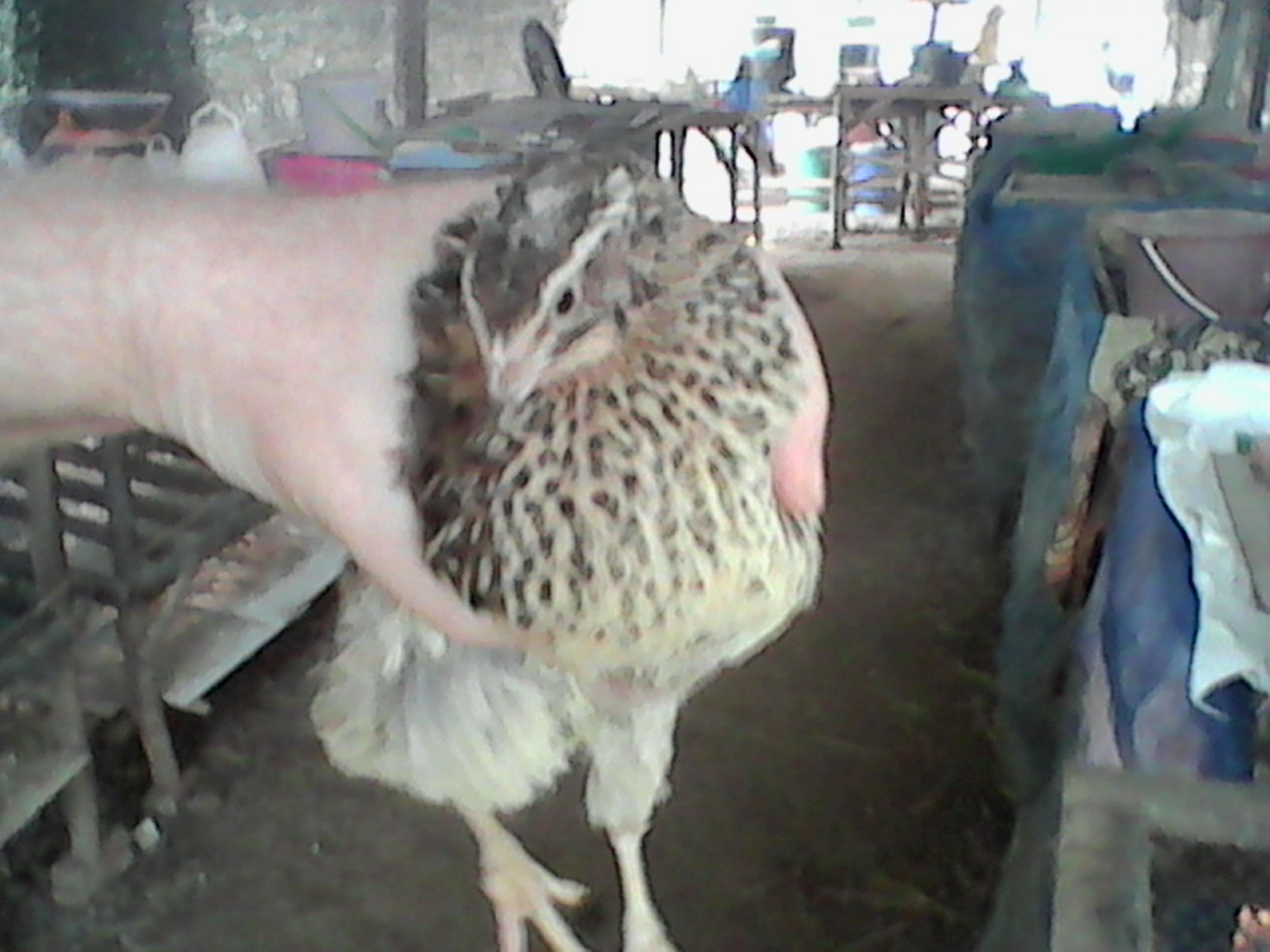
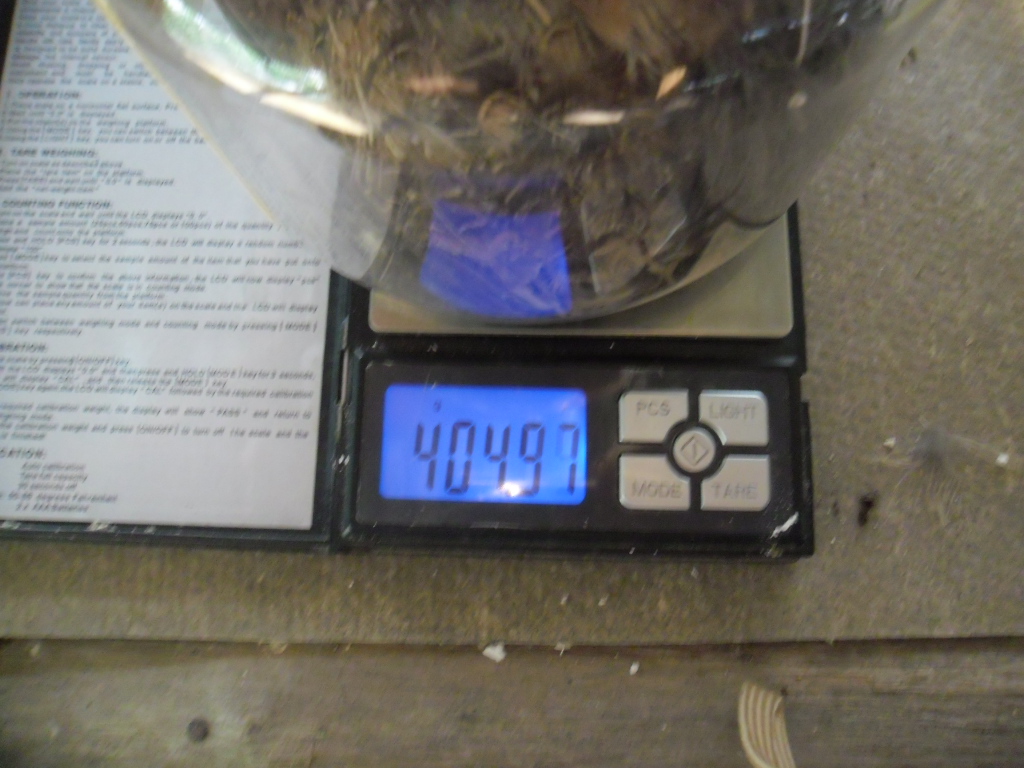
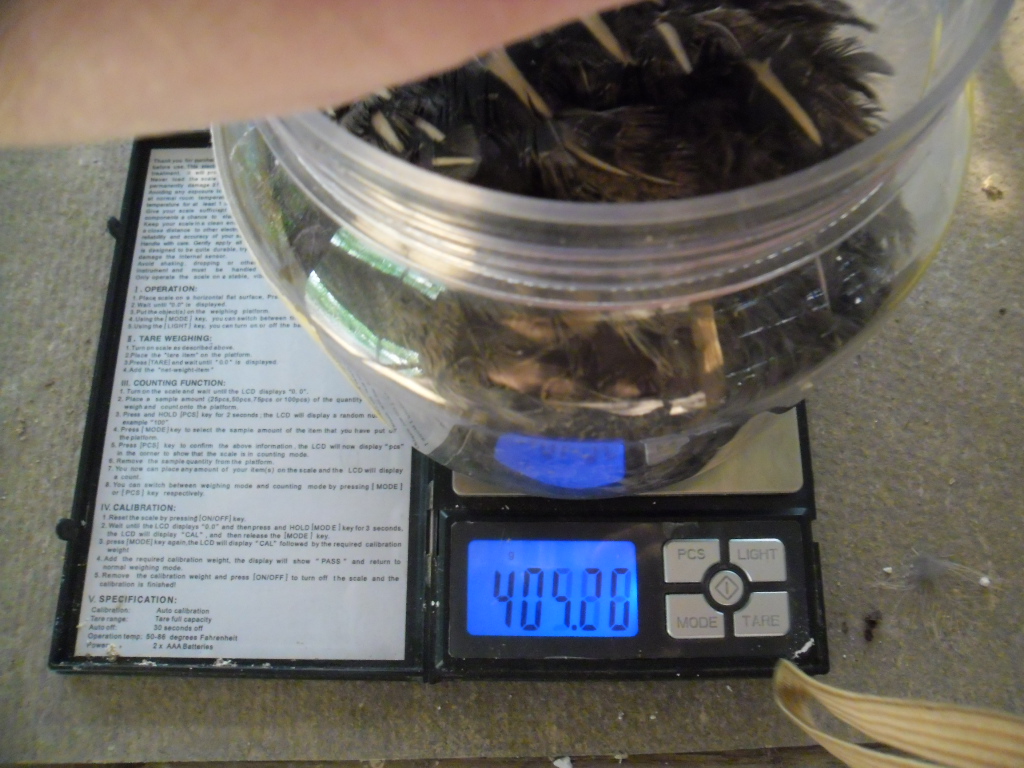

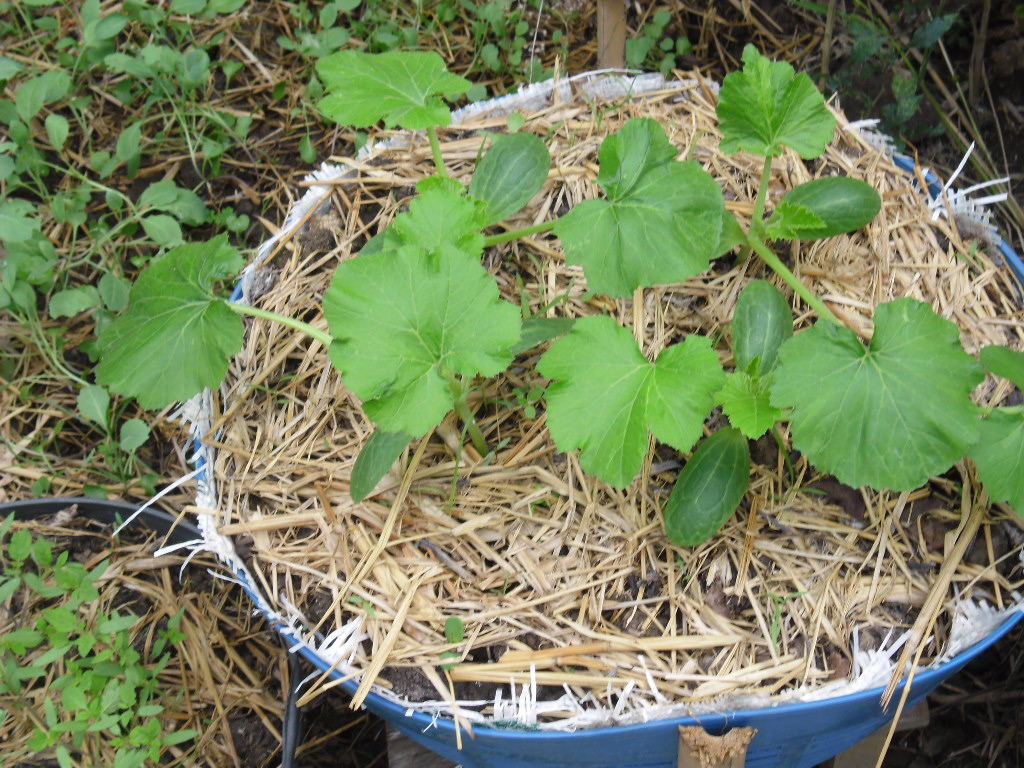
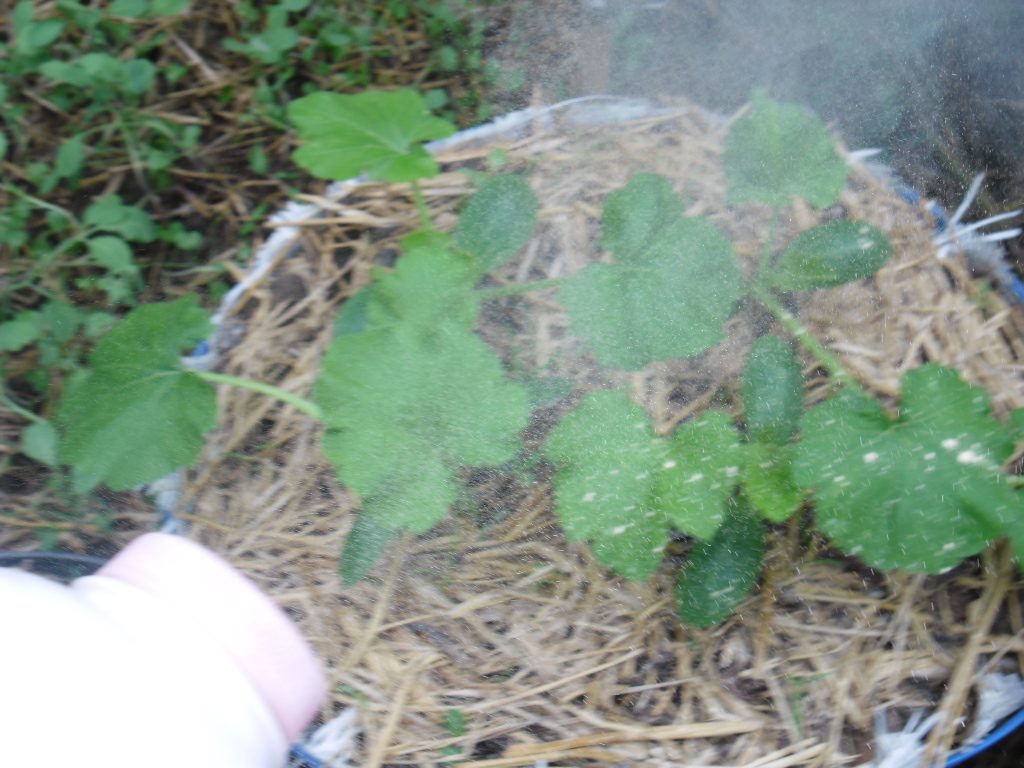



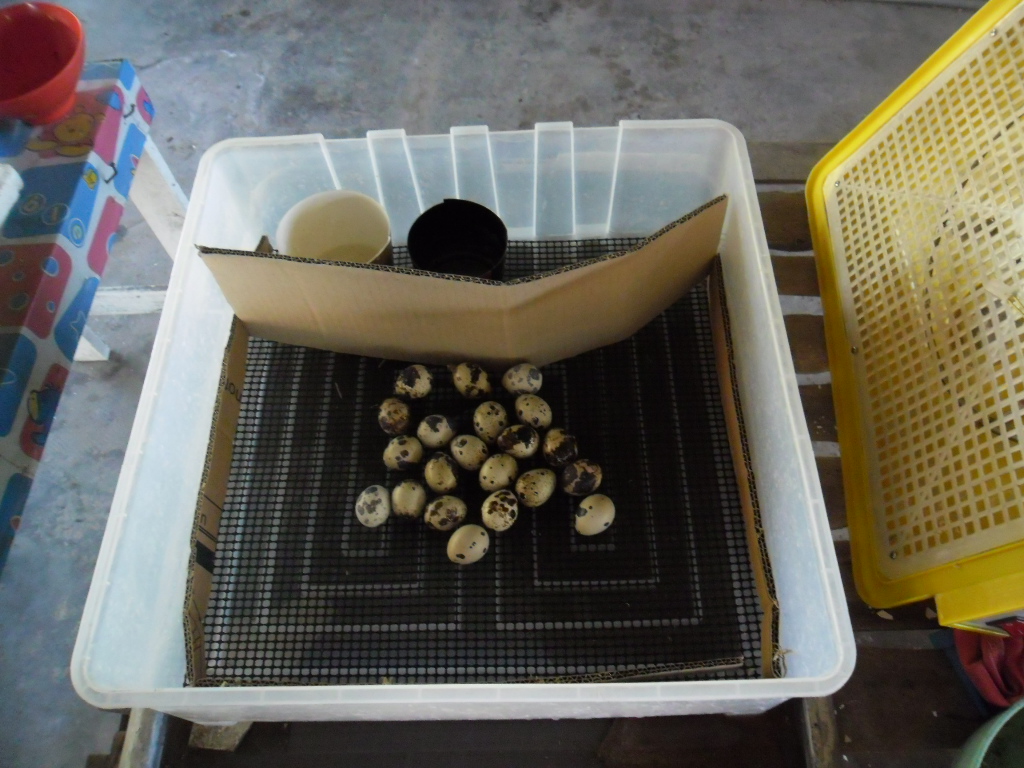

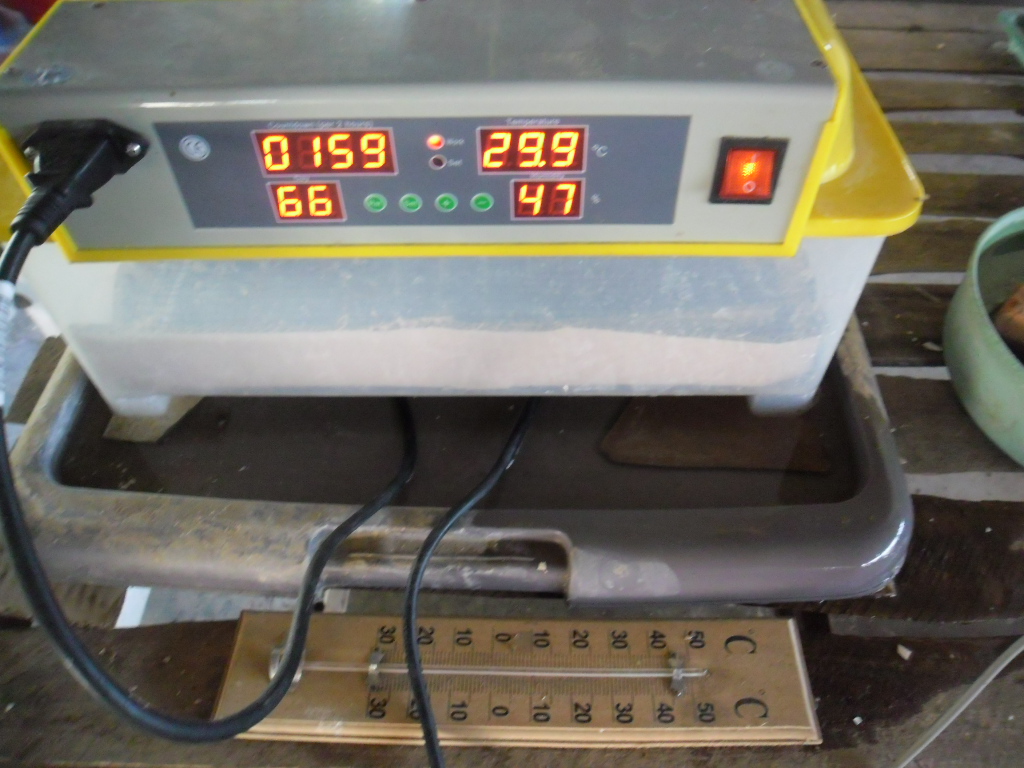


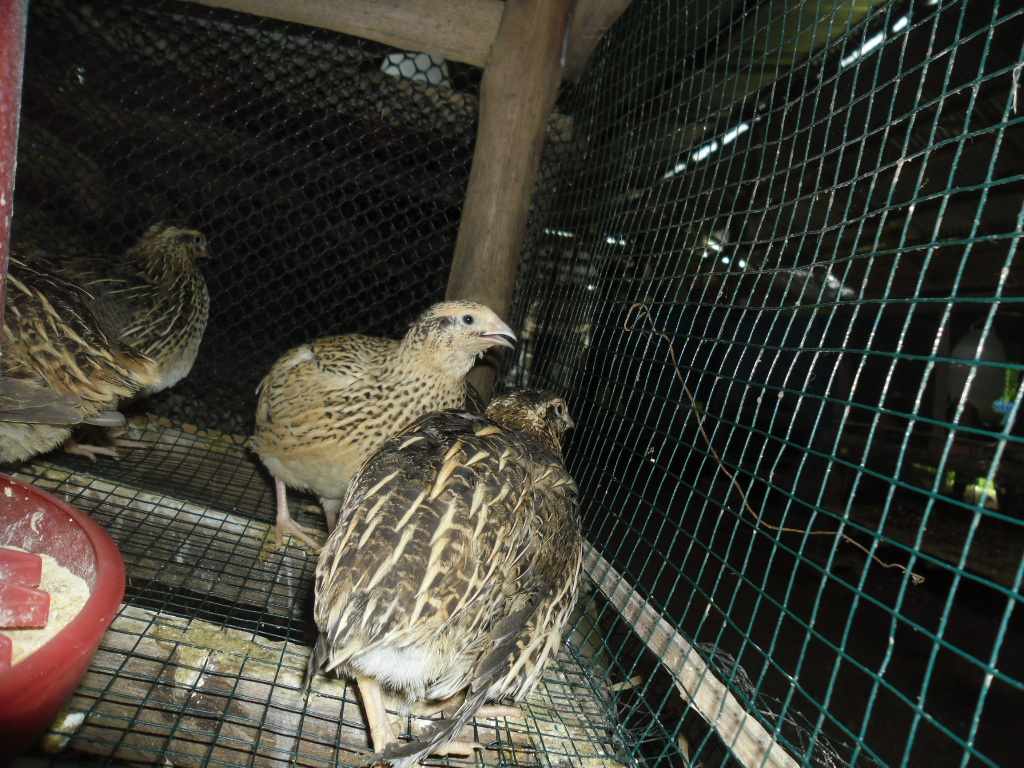
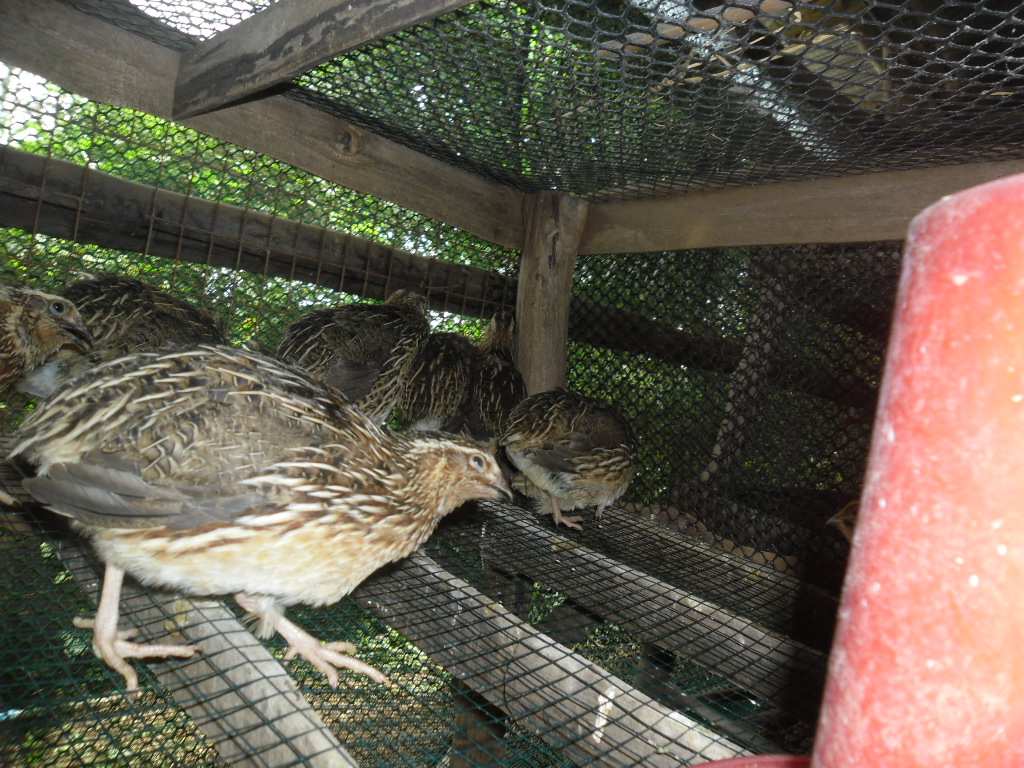
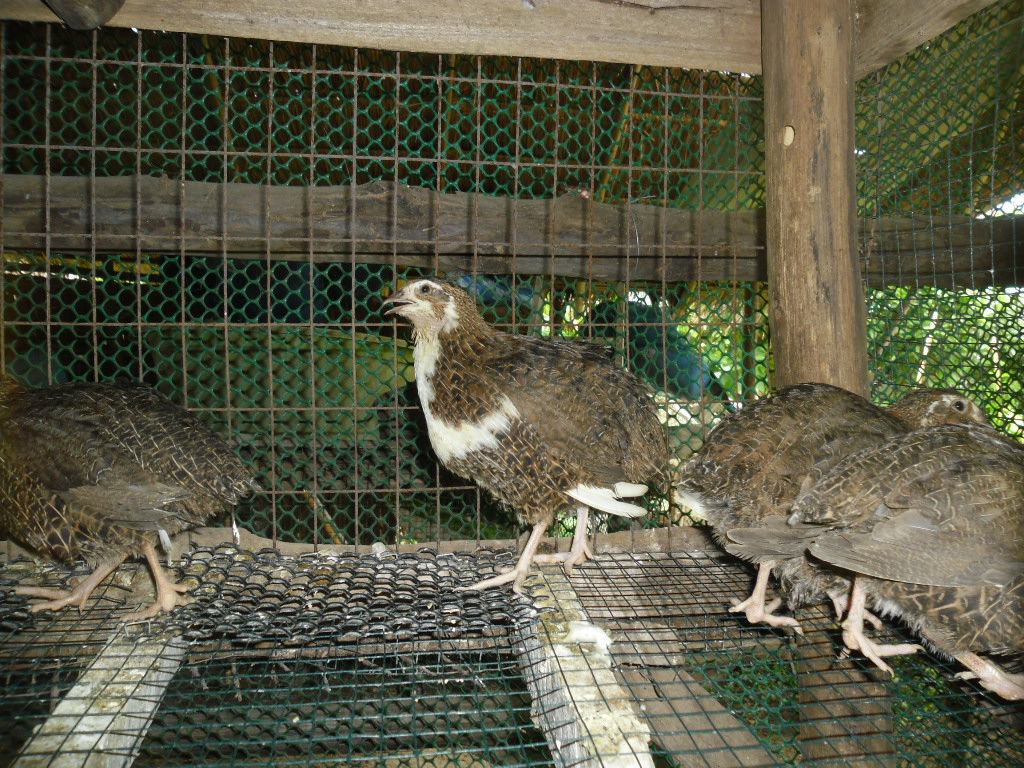

My Quail Project
in Farming in Thailand Forum
Posted
I am almost done with installing 15 cm of plastic mesh around the inside perimeter of the cages.....this is where they do 90% of their walking.
Could I ask if you have a lighting program, I know there is plenty of info online. With commercial ducks and poultry it is normally 23 hours and with breeders a shorter lighting program. I played around with light intensity and types of lighting with commercial chickens in Saudi Arabia back in the 1980's, interesting results.
Perhaps modifying it slightly could increase feed intake during a cooler time of day ?
I have the amber bio-lights, that repel mosquitoes, on a dusk to dawn light sensor. They don’t light up the area very well, but enough to do the job and still let them rest. I just let them eat when they want to, but I give their supplemental food in the morning.
Have you managed to breed from heavier males / females yet ?
I use the largest males I can get to get between 3:1 and 4:1 female to male ratio. For this generation of breeders the cutoff was 280 grams.
Any issues with prolapsed either male or female?
I’ve had the odd female die when they are just beginning to lay…..same as egg-bound females.
I am just beginning to collect eggs from this generation of breeders. I just started gathering my first batch which will be eggs at 16-18 grams. I will probably set about 20 eggs ( just a test batch and to have a few to eat)….I wish it wasn’t so hot. My plan is to hold off setting large numbers until the birds are older and have gone through another cull to help select for longevity. As the hens age, the egg size will increase and I will be able to set more eggs. I am also going to (starting tomorrow) separate out every hen ( about 48) to evaluate for egg laying. I also plan to set a batch of eggs between 15-16 grams to see what happens. For my next generation of breeders I hope to be able to cull all hens under 350 grams and males under 300 grams. Half of my hens now are over 350.